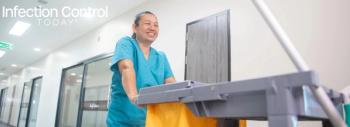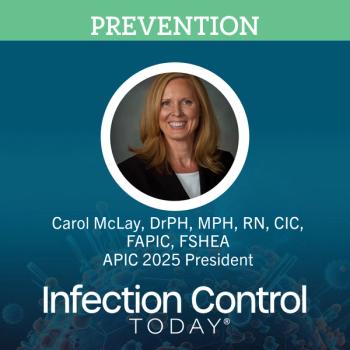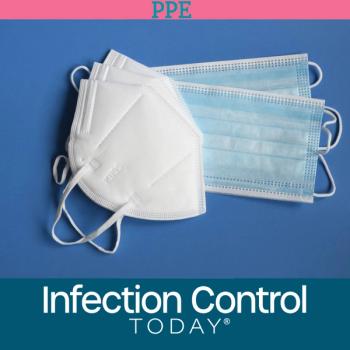
- Infection Control Today, January/February 2022, (Vol. 26, No. 1)
- Volume 26
- Issue 1
Some Cleaning Methods May Contaminate Health Care Workers and PPE
“[Personal protective equipment] was splashed during most activities and did not prevent skin exposure even when properly donned and doffed,” the study states.
Routine cleaning methods used to reprocess medical instruments could expose health care professionals to dangerous pathogens due to the splashing in sinks and other areas that it involves. It also matters what kind of personal protective equipment (PPE) the individuals are wearing. Those are 2 of the findings of a study published in December’s American Journal of Infection Control.1
“This hypothesis-generating pilot project found that routine reprocessing activities generated substantial splashing, and currently recommended personal protective equipment did not adequately protect sterile processing personnel from exposure,” wrote the investigators, 1 of whom works at St Luke’s Hospital in Cedar Rapids, Iowa, and 3 others who work at the medical research firm Ofstead & Associates in St Paul, Minnesota.
Investigators gathered data by covering environmental surfaces and PPE with moisture detection paper. They then studied the droplet dispersal after health care workers performed routine reprocessing tasks.
“Visible droplets were generated during every reprocessing activity except running the sonication sink,” the authors wrote. “Droplets traveled at least 3 feet when filling a sink, brushing a ureteroscope, and using a power sprayer to rinse a basin. Some activities dispersed droplets up to 5 feet from the sink. [PPE] was splashed during most activities and did not prevent skin exposure even when properly donned and doffed.”
The authors noted that there is a lack of evidence about how traditional cleaning methods may contribute to contamination.
“A rigorous search identified no peer-reviewed journal articles describing the exposure of personnel to bloodborne pathogens or viruses during manual cleaning in endoscopy or sterile processing department [SPD] areas,” the authors wrote. “Likewise, the effectiveness of protective measures for reprocessing personnel has not been systematically evaluated in real-world settings.”
Gently placing a ureteroscope in the sink generated fewer droplets than if workers dropped the instrument into the water.
“However, droplets were visible on horizontal and vertical surfaces near the sink and on PPE no matter how carefully the instrument was placed in the water,” the authors wrote. “The use of an air gun to dry the ureteroscope dispersed droplets visible on vertical surfaces near the sink and PPE.”
Routine sterilization or reprocessing activities generated substantial splashing in decontamination sinks that could fling droplets up to 5 feet away.
“Currently recommended PPE did not adequately protect SPD personnel from exposure to clean water and cleaning solution during simulated activities, which would be presumed to be highly contaminated during normal daily activities,” the authors wrote. “In the context of PPE shortages [such as] those seen during COVID-19, reprocessing personnel should be prioritized with regard to high-quality, well-fitting PPE and training on using and doffing to protect them against splash exposure.”
The authors also stated that manufacturers of PPE should be encouraged to develop engineering solutions that would reduce the risk of contaminating health care professionals.
“The potential for personnel exposure seems high in the best of circumstances,” the authors wrote. “However, due to the COVID-19 pandemic, there have been shortages of many PPE components, and they have been rationed, worn for extended periods, or reused with or without being decontaminated between uses.”
Reference:
Ofstead CL, Hopkins KM, Smart AG, Brewer MK. Droplet dispersal in decontamination areas of instrument reprocessing suites. December 2, 2021. Accessed December 8, 2021. https://www.ajicjournal.org/article/S0196-6553(21)00689-1/fulltext
Articles in this issue
almost 4 years ago
Add Biopreparedness to IP Checklistalmost 4 years ago
Infection Control in Dentistry Before, During, and After COVID-19almost 4 years ago
Brushing Up on Sterile Processing in Dentistryabout 4 years ago
Changes COVID-19 Brought to Long-Term Care Facilitiesabout 4 years ago
Going Deep: Cleaning Potential of Electrostatic Sprayersabout 4 years ago
Omicron More Likely Than Delta to Cause COVID-19 Reinfectionabout 4 years ago
Immune Changes in Mothers, Infants Linked to COVID-19 Infectionabout 4 years ago
COVID-19 Spread: Droplets or Particles? It’s Not an Either/Orabout 4 years ago
COVID-19 Vaccine Uptake Among Health Care Workers Hits WallNewsletter
Stay prepared and protected with Infection Control Today's newsletter, delivering essential updates, best practices, and expert insights for infection preventionists.






